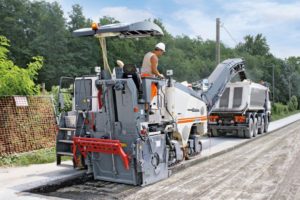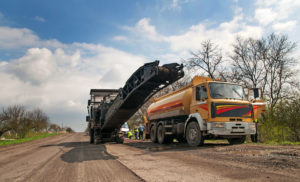
Asphalt Milling is the controlled process of removing existing pavement to prepare the site for a new layer of asphalt. Milling creates a smooth surface for better and safer driving. Smooth pavement improves fuel efficiency for all vehicles.
In many cases, asphalt milling is more economical than digging out the old blacktop with an excavator. Milling removes the top layer of asphalt (or more) to create an even, uniform surface. The asphalt millings are loaded onto trucks and taken to the local asphalt producers to be ground up and reused in new hot asphalt mix. This recycling process helps to minimize wasted asphalt. American taxpayers save approximately $1.5 billion each year when paving companies recycle used asphalt.
If you’re interested in asphalt removal, paving, or excavation, we service The Greater Rochester Area and the surrounding regions, including Webster NY, Monroe County, Williamson, Ontario, and more!
Asphalt Milling Restores Pavement
 Milling removes divots, potholes, swells, bumps, and depressions from the pavement by removing a layer of asphalt. You can remove the surface area, typically about 1-6 inches deep, or the full depth of pavement, depending on how deep the damage penetrates the asphalt. Milling has many pseudonyms, including
Milling removes divots, potholes, swells, bumps, and depressions from the pavement by removing a layer of asphalt. You can remove the surface area, typically about 1-6 inches deep, or the full depth of pavement, depending on how deep the damage penetrates the asphalt. Milling has many pseudonyms, including
- Asphalt Milling
- Profiling
- Cold Planing
- Pavement Milling
In the past, we’ve milled large parking lots, roads, and private drives. Our large milling machine mills a path 4 ft. wide and 1-12 inches deep. Our small milling machine is a skid steer with a milling head attachment, which we use for smaller milling projects, such as small to medium sized patches, milling rebates, and milling trenches through parking lots. Our skid steer milling machine mills a path 2 ft. wide and 1-6 inches deep.
How to Recycle Used Asphalt
During our milling projects, we collect the old asphalt millings and transport it to our local asphalt producers for recycling. At the asphalt plants, they crush and screen the old asphalt chunks into R.A.P (Reclaimed Asphalt Pavement). They then add the R.A.P into new, hot asphalt mixes. Typically, anywhere from 10%-20% of R.A.P is reused in new hot asphalt mixes. Millings are also a great product to install over the top of existing stone-based driveways, parking lots, and private drives.
Regular Maintenance for Asphalt Pavement
 Milling is a huge part of regular maintenance for roadways. Most roads need to be milled approximately every 15 to 20 years, and then repaved to maintain a smooth driving surface.
Milling is a huge part of regular maintenance for roadways. Most roads need to be milled approximately every 15 to 20 years, and then repaved to maintain a smooth driving surface.
Asphalt pavement deteriorates over time, so it needs regular maintenance to keep drivers safe on the road. The aggregate can become loose and start to unravel from the road (a distortion called raveling). The binder can also bleed through the aggregate and settle on the surface of the road (called bleeding). Asphalt milling effectively shaves these blemishes away and prepares the road surface for a new layer of asphalt.
Milling restores pavement that has been damaged by weather, erosion, car accidents, or the freeze-thaw process of freezing temperatures common to upstate New York. It can also remove rut marks made from traffic, and ripple-like distortions that appears contrary to the direction of traffic, usually where frequent stops and starts occurs.
As a sustainable process, milling can be performed on the same pavement site as many times as needed. Since the asphalt millings are removed and recycled, it is one of the most economical options for road work rather than full demolition.


